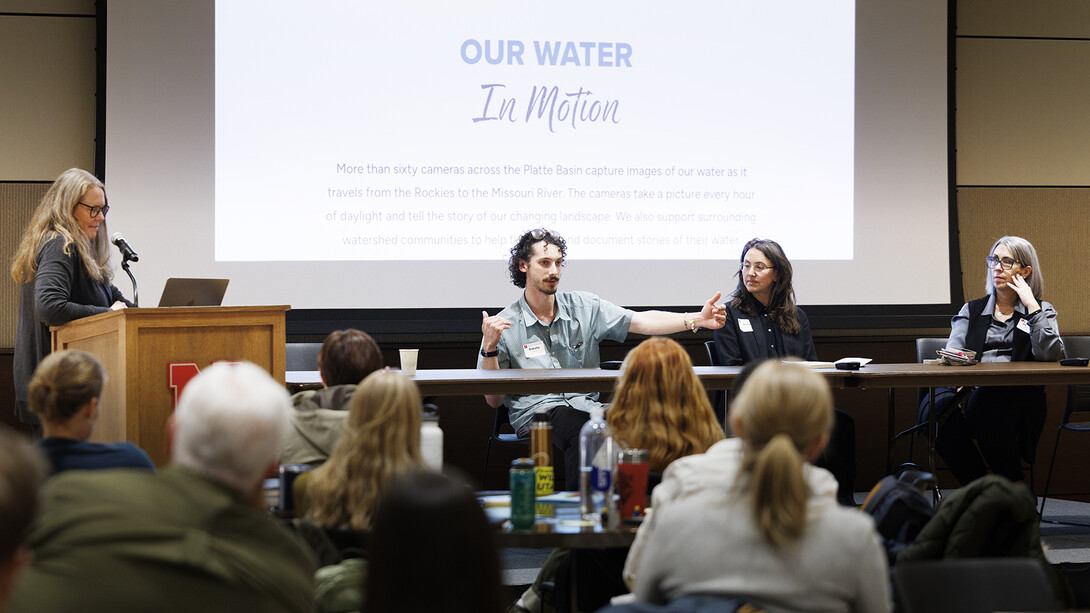
More than 100 people gathered Feb. 27 at the Nebraska East Union to share how climate has affected their lives and livelihoods in recent years — and to offer ideas how to make communities more resilient to future climate events.
The event was part of an initiative growing out of the university’s N2025 strategic plan, where climate resilience was named as one of seven “Grand Challenges” to be tackled through research and creative activity. With an $80,000 planning grant provided through the university’s Office of Research and Economic Development, a multi-disciplinary group of about 25 faculty members is working to develop the Great Plains Community Climate Resilience Institute.
“We’re trying to build an umbrella organization across UNL, where people who are interested in this topic can bring their expertise and perspective and collaborate with one another,” said Clinton Rowe, chair of the Department of Earth and Atmospheric Sciences and a leader of the effort. “Scientists studying climate need to be able to address the broader social implications. The poets and artists and communicators can provide that.”

Compared to 10 years ago, when a group of university climatologists authored Nebraska’s first climate assessment report, a growing share of Nebraskans believe climate change is already harming people in the U.S., according to statistics from the Yale Climate Opinion Maps cited by Deborah Bathke, interim state climatologist.
However, the proportion is just over half of the state’s population — and less than a third of Nebraska residents — regularly discuss climate change.
“People aren’t talking about climate change,” Bathke said. “We need to increase the number of people who are talking about it.”
At the start of event, participants were urged to tell personal stories and perhaps share items that show how climate has affected them and their communities. Facilitated by Lisa PytlikZillig, a research associate professor from the University of Nebraska Public Policy Center, and Tonya Bernadt, education and outreach specialist from the National Drought Mitigation Center, the activity was patterned after the “History Harvest” program created by the University of Nebraska–Lincoln’s Department of History, where historians visit various communities to digitally record recollections and artifacts.
Graham Christensen, a family farmer from Burt County, Nebraska, told how his family is adopting more sustainable farming practices, including some used by indigenous people and diversified farmers of the past, as well as implementing solar energy and other renewable energy sources. James Rattling Leaf Sr., coordinator of climate partnerships for the Great Plains Tribal Water Alliance in Black Hawk, S.D., told of a December 2022 blizzard that hit the Rosebud Indian Reservation.
“Even though we had emergency plans on paper, we could not get food and water to people,” he said. “People died in that blizzard because we could not reach them.”

Several others recounted repeated floods and wildfires that threatened or destroyed their homes, often erasing family assets accrued over generations.
The event also featured Lance Hedquist, city administrator for the Sioux City; Lincoln Sustainability Director Kim Morrow, sustainability director for the City of Lincoln; Robert Laroco, city planner for the City of Omaha; and Josh Moenning, mayor of Norfolk, Neb., who told of their communities’ efforts to plan for droughts, floods, heat waves and other violent weather events, along with greenhouse gas inventories and efforts to encourage recycling, renewable energy, alternate transportation and tree planting.
Dana Fritz, a photographer and professor of art from the Hixson-Lied College of Fine and Performing Arts, joined Bathke to discuss how artists and communicators could work with scientists to inspire action by conveying the social and emotional effects of climate events, along with the scientific data and hypotheses.
Rowe said similar events are being considered for other Nebraska communities in coming months to gather more information to support a grant funding request to begin creating the institute in 2024-25.
The proposed institute’s aim would be to build upon successful efforts and incorporate local and indigenous wisdom into resilience plans, as well as to address lack of knowledge about how the climate is changing, ineffective resilience strategies and inadequate community capacity to develop resilience plans, Rowe said.
The institute would rely upon “convergent” collaboration among people from many different perspectives and background to generate new ideas for how the university can support climate resilience work and forge meaningful partnerships with communities.








